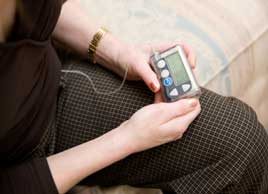Insulin pumps: What you need to know
It’s convenient and portable, but is an insulin pump right for you?

Source: Web exclusive, September 2011
Are you wondering about using a pump for insulin therapy? Many people use this insulin delivery method because it carries a lot of conveniences, and can often make it easier to manage the effects of diabetes. “If somebody has been working with their insulin and having a struggle getting control, this may be the next step to take,” says clinical pharmacist and certified diabetes educator Rob Roscoe in Rothesay, N.B. Is a pump right for you? Here are your questions answered.
What is an insulin pump?
An insulin pump is a device that delivers insulin. It replaces the traditional methods of injecting insulin with a syringe or pen. The pump is about the size of a cellphone and can be worn on your belt or kept in a pocket. The pump is connected to a thin tube that stays inserted under your skin. The injection site is changed about every three days.
How does it work?
The pump sends insulin into your body through the tube. You can program it to give you insulin automatically, on a schedule that matches your body’s usual needs. You can also take extra insulin if you need to, depending on your meals or activity level, just by pressing a button. "The pump is probably the closest we can get to the natural production of insulin in our body," says Roscoe. "It can give a person with diabetes as close to a normal life as possible."
Why do people use pumps?
Many people with diabetes find advantages to using an insulin pump instead of giving themselves a separate injection every time they need insulin. Not only does it eliminate the need to prepare doses one by one, but it usually gives more accurate doses than individual injections. It gives you more control over your blood glucose levels, with fewer highs and lows, even when you exercise. It also gives you more flexibility with your meals. For some people, it means being able to sleep in or go out for a treat.
Who is it right for?
Lots of people are good candidates for pumps. Those who are taking insulin injections four or five times a day may want to consider the convenience of a pump. And adults with irregular schedules might benefit from a pump, as well as growing children ‘ including picky eaters! But they (or their parents) should also be prepared to do some planning in order to use the device effectively. In the beginning, using a pump can involve a lot of blood glucose testing, meal planning, and thinking about activities and what may affect blood sugar levels. "You have to be motivated," Roscoe points out. "It can be a lot of work at first, but after working with the pump for a while it becomes second nature."
Where do I sign up?
Before you run to your healthcare practitioner to talk about an insulin pump, be aware that there are a few disadvantages. You’ll need a lot of training to get comfortable using the pump. You’ll have to change the injection site on your body about every three days, and you may experience skin irritation. You need to stay connected to the pump most of the time ‘ and if it is accidentally detached, there’s a risk that your blood sugar will rise dangerously high. Side effects of the pump also include possible weight gain.
Plus, if the pump and supplies aren’t covered by your provincial health plan, the expenses can really add up. The pump itself can cost up to $7,000, and monthly supplies can run up another $200 or so. Coverage varies by type of private insurance. Some provincial health plans may have coverage for insulin pump therapy, so it’s important to consult with your ministry of health.
If you think an insulin pump might be the best choice for you to manage your diabetes, talk to your health professional about the options. "I’ve seen people turn their lives around with insulin pumps, because they have the best diabetes control they’ve had in a long time," Roscoe says.
Don’t miss out! Sign up for our free weekly newsletters and get nutritious recipes, healthy weight-loss tips, easy ways to stay in shape and all the health news you need, delivered straight to your inbox.




